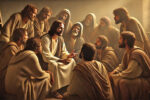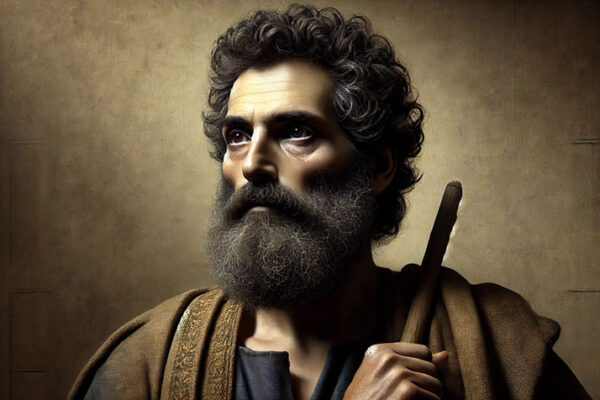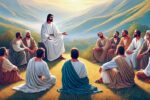Apostle Simon Peter
Who was the Apostle Simon Peter?
Simon Peter was one of the twelve disciples of Jesus. He was a fisherman by trade when Jesus called him. The name ‘Peter’ was given to him by Jesus, which means “rock” and Jesus later said that Peter would be the “rock” on which he would build His church. Peter, along with James and John were part of Jesus’ inner circle, and Peter is also considered a ‘pillar’ of the church along with James and John.
Call to Discipleship
According to the Gospels, Jesus saw Simon (Peter) and his brother Andrew casting a net into the sea and He said to them, “Follow me, and I will make you fishers of men” (Matthew 4:19). And at once they left their nets and followed Him.
Significant Characteristics
1. Impulsive and passionate: Peter was known for his impulsive nature, as seen when he tried to walk on water (Matthew 14:28-30) or when he cut off the ear of the high priest’s servant (John 18:10). There are also other instances like his spontaneous suggestion at the Transfiguration (Mark 9:2-13) and his attempt to dissuade Jesus from taking the path of suffering (Mark 8:31-33).
2. Bold yet fallible: When Jesus asked His disciples, who they thought He was, Peter was bold to proclaim Jesus as the Messiah. (Matthew 16:15, 16) Yet, it was the same Peter who denied knowing Jesus three times to save his life, as fear overtook his faith (Matthew 26:69-75).
3. Natural leader: Peter was often the first to speak or act among the group of disciples. His question about forgiveness (Matthew 18:21) that led to Jesus’ further teaching on the subject, and his walking on water (Matthew 14:28-31) to name a few, demonstrate this characteristic. Peter later became a prominent leader in the early church.
4. Inner Circle: Peter, along with James and John (the sons of Zebedee) were were often referred to as the “inner circle” of Jesus or the “pillars” of the early church. They were chosen to be part of certain important events like the Transfiguration and Jesus’ agonizing moments in the Garden of Gethsemane.
Contributions to the Church
Peter played a significant role in the establishment and leadership of the early church in Jerusalem, and also traveled widely to carry the Gospel to many places through his missionary journeys.
1. Ministry Jerusalem & Judea: Jesus designated Peter as the “rock” on which He would build His church (Matthew 16:18). True to that designation, he was instrumental in organizing the early church and played a key part in the events at Pentecost (Acts 2), where his sermon led to the conversion of about 3000 people. Peter continued preaching in and around Jerusalem, performing miracles and spreading the gospel.
2. Ministry in Samaria: Peter, along with John, traveled to Samaria after hearing that the Samaritans had accepted the word of God through Philip’s ministry (Acts 8:14-25). They prayed and strengthened the new believers of that area.
3. Ministry in Lydda & Joppa: Peter healed a man named Aenas in Lydda (Acts 9:32-35) that caused many in the town to accept the Gospel. He raised a woman named Tabitha from the dead in Joppa (Acts 9:36-43) that further established him as a leader filled with God’s power. In Joppa he received a vision from God, that opened the Gospel to all people, not just Jews.
4. Ministry in Caesarea: Peter’s time in Caesarea is significant because it marked the beginning of the church’s outreach to the Gentiles. After his vision, Peter was invited to the house of the Roman centurion Cornelius, where he and his household received the Gospel and were baptized. Peter was the first Apostle to extend the Gospel to the non-Jews (Acts 10:1-48).
5. Ministry in Antioch: Antioch was one of the major centers of Christianity, and it was here that followers of Christ were first called Christians. Here Paul confronted Peter about his behavior regarding gentile believers. Peter initially ate with the Gentiles but later withdrew when Jewish Christians from Jerusalem arrived. Paul rebuked Peter for this inconsistency (Galatians 2:11-14). This incident shows Peter’s struggles as the early church navigated Jewish and Gentile tensions.
6. Other Missionary Travels: While the Book of Acts and the Epistles mainly focus on Peter’s work in Judea, Samaria, and parts of Asia Minor, early Christian tradition and writings suggest that Peter’s ministry extended much farther.
Asia Minor: Some traditions suggest that Peter traveled through regions of modern-day Turkey, including Pontus, Galatia, and Bithynia (1 Peter 1:1). His First Epistle is addressed to Christians in these areas, indicating his pastoral influence there.
Rome: According to early Christian tradition, Peter eventually made his way to Rome, where he played a crucial role in establishing the church. Though the New Testament doesn’t explicitly mention Peter’s time in Rome, historical sources like the writings of early church fathers (e.g., Clement of Rome, Irenaeus, and Tertullian) state that Peter served as a bishop and was martyred there. His presence in Rome was crucial for the growth of Christianity in the heart of the Roman Empire. It is also most likely that the two epistles of Peter, 1 Peter and 2 Peter were written during his time in Rome.
Corinth: There are hints that Peter may have visited Corinth, Greece. Paul mentions a group in Corinth that identified with Peter (1 Corinthians 1:12), indicating that Peter likely ministered there.
Martyrdom
While the New Testament doesn’t record Peter’s death, according to Church history Peter is believed to have been martyred in Rome during Nero’s persecution of Christians, around 64-68 AD. Tradition says he was crucified upside down at his own request, feeling unworthy to die in the same manner as Jesus.
Testimony & Legacy
Peter’s life testifies a dramatic transformation from an impulsive fisherman to a bold church leader, demonstrating the power of faith and the Holy Spirit in a believer’s life.














